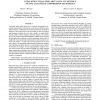Free Online Productivity Tools
i2Speak
i2Symbol
i2OCR
iTex2Img
iWeb2Print
iWeb2Shot
i2Type
iPdf2Split
iPdf2Merge
i2Bopomofo
i2Arabic
i2Style
i2Image
i2PDF
iLatex2Rtf
Sci2ools
ICASSP
2007
IEEE
2007
IEEE
Using Structural Similarity Quality Metrics to Evaluate Image Compression Techniques
Perceptual image quality metrics have explicitly accounted for perceptual characteristics of the human visual system (HVS) by modeling sensitivity to subband noise as the just-noticeable threshold of distortion. While such metrics can successfully account for contrast and luminance masking, they are quite sensitive to spatial shifts, intensity shifts, contrast changes, and scale changes. In contrast, the recently proposed Structural SIMilarity (SSIM) metrics account for perception more implicitly with the assumption that the HVS is adapted for extracting structural information (relative spatial covariance) from images. As such, they have the potential to be much more effective in quantifying suprathreshold compression artifacts than traditional perceptual metrics, as such artifacts tend to distort the structure of an image. We use a (perceptually) weighted variation of the Complex Wavelet SSIM (CWSSIM) to evaluate standard image compression techniques such as JPEG, JPEG 2000, SPIHT, a...
| Added | 02 Jun 2010 |
| Updated | 02 Jun 2010 |
| Type | Conference |
| Year | 2007 |
| Where | ICASSP |
| Authors | Alan C. Brooks, Thrasyvoulos N. Pappas |
Comments (0)

